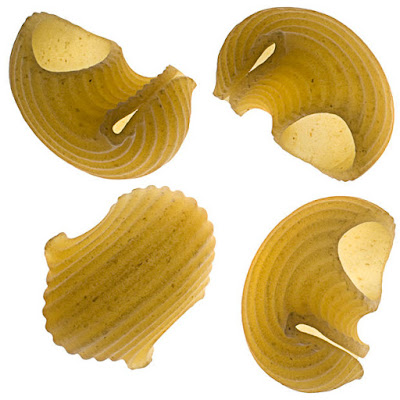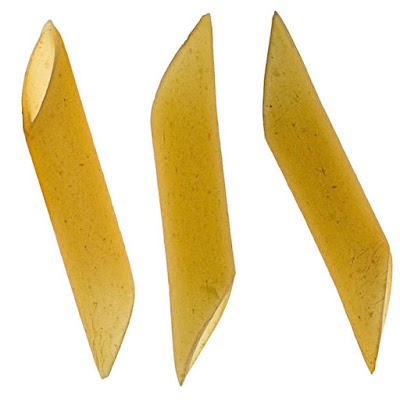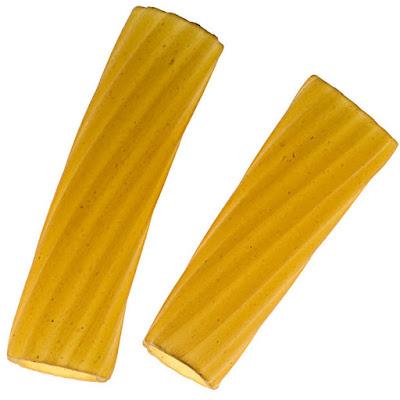Did you know that choosing a pasta shape
to suit the nature of your sauce makes a big difference to the finished dish?
ok - Before I jump into the subject of this blog, I thought I would give you just a little background on my pasta knowledge:
I grew up in a small town in Ohio that had a very high
percentage population of Italian Americans. When I was very small (maybe 4 or 5 years old), my family lived on
the same little lane as a wonderful loving matriarch of one of the largest Italian families in
town. They owned a very popular Italian restaurant there. I used to wander
down the lane to her home (not more than a hundred steps or so) and spend many afternoons with this 'substitute grandmother'. I remember being spoiled, just like a
grandmother should do. There always seemed to be luscious goodies (Italian, of course) awaiting me to nibble on as we spent our afternoons together. Some days, she spent her time in her basement
where large wooden tables (along with the cement floor) were covered in a dusting of white flour. I was always, of course, welcome to accompany her down the stairs and lend a small,
inexperienced helping hand. There, in that little oasis of warmth from love, scents from flour powder and yumminess (yeah, I think I just made that word up... but it's a good one, isn't it?) from everything imaginable,
we would make all types of pastas. Oh, my
goodness, just the memories of this experience now fill my nostrils with scents of ‘heaven
on earth’. What a lasting impression this woman made on me. Do you think she even knew? Even at this young of an age, I now remember and recognize and appreciate
the labor of love that was given to create delicious food for loved ones.
So even though I may not be 100% Italian, I know my ziti from my fusilli
and I am going to share a little bit of this knowledge with you.
First off, we all know Spaghetti Bolognese as one of the world's most
well-known pasta dishes, but guess what - it is fundamentally inauthentic. Italian
cooks would seldom serve a thick, saucy ragu
with thin pasta ribbons - they're far more likely to team such a sauce with
large shells or tubes to capture the sauce, or thicker long pasta, like
tagliatelle and pappardelle.
The
general rule is that delicate noodles are for delicate sauces while heartier
noodles are for heartier sauces, but similar to wine pairing, it’s not always
that simple. So, here’s a guide to help you sort it all out. And if you can’t
tell your radiatore from your penne, I even found gorgeous pictures (compliments of Chowhound) to
accompany the guide. Did you know that there are more that 370 shapes of pasta in Italy, it's true!
Plus, we all need a little visual help when we walk down the daunting pasta isle in our grocery store. And oh brother, don't even get me started on the overwhelming choices in a specialty store, wow.
Plus, we all need a little visual help when we walk down the daunting pasta isle in our grocery store. And oh brother, don't even get me started on the overwhelming choices in a specialty store, wow.
Pasta: ACINI DE PEPE | Sauce: SOUP
Acini di
pepe are literally “little peppercorns,” named for their tiny ball shape.
Reminiscent of Israeli couscous, you’ll find them floating in recipes like
Italian wedding soup.
Pasta: ANELLI/ANELLINI |
Sauces: PASTA SALAD, SOUP
Anellini
are, wait for it… little rings. These round pieces are best eaten by the
spoonful.
Pasta: BUCATINI | Sauces: BAKED, TOMATO
Bucatini is a long, pipe-shaped pasta with a hole in the
center—just wide enough to soak up a few saucy juices.
Pasta: CALAMARI | Sauces: SEAFOOD, TOMATO
These
pasta bands are named for their squid-like shape, and are best with other
shapely ingredients and sauces with a bit of substance.
Pasta: CAMPANELLE | Sauces: BUTTER/OIL, CREAM/CHEESE, MEAT, PASTA
SALAD, VEGETABLE
Campanelle
are bells, just the perfect size for pocketing little nubs of cheese, veg, or
meat.
Pasta: CAPELLINI (a.k.a. ANGEL HAIR) | Sauces: BUTTER/OIL,
CREAM/CHEESE, PESTO, SEAFOOD, SOUP, TOMATO, VEGETABLE
Light and
ethereal, these wispy strands do well with lighter, thin sauces.
Pasta: CASARECCE | Sauces: CREAM/CHEESE, MEAT, PESTO, SEAFOOD,
TOMATO, VEGETABLE
Casarecce
literally means “homemade,” owing to their loose, free-form shape. Their
crevices are great for soaking up sauce.
Pasta: CAVATELLI | Sauces: CREAM/CHEESE, MEAT, PASTA SALAD, SOUP,
VEGETABLE
Cavatelli
is “to scoop” in Italian, appropriate for the hot dog bun–style crevices in
cavatelli. They’re a signature shape in the southern region of Puglia.
Pasta: CAVATURI | Sauces: PASTA SALAD, VEGETABLE
Cavaturi
also have that scooped center, but are slightly longer and scroll-like.
Pasta: CONCHIGLIE | Sauces: CREAM/CHEESE, MEAT, PASTA SALAD,
PESTO, TOMATO, VEGETABLE
Named for
their conch shell–like appearance, these tubes can hold ample amounts of
liquid.
Pasta: DITALINI | Sauces: BAKED, PASTA SALAD, SOUP
These
“tiny fingers” are a classic choice for soups like pasta e fagioli, although
they are a great choice for soaking up cheese and sauce in bakes, too.
Pasta: FARFALLE | Sauces: BUTTER/OIL, CREAM/CHEESE, MEAT, PASTA
SALAD, PESTO, SEAFOOD, SOUP, TOMATO, VEGETABLE
We may
know them as bow ties, but these all-purpose shapes are actually named for
fluttering butterflies.
Pasta: FETTUCCINE | Sauces: BUTTER/OIL, CREAM/CHEESE, MEAT,
SEAFOOD, TOMATO, VEGETABLE
A
versatile favorite, fettuccine is “little ribbons,” working famously with
Alfredo sauce, but also holding steady against robust meat, seafood, and
vegetables.
Pasta: FREGULA | Sauces: SOUP, TOMATO
A
Sardinian specialty, these grain-like bits add a chewy bite to soups and more.
They’re usually toasted, giving them a brown-hued cast.
Pasta: FUSILLI | Sauces: BAKED, BUTTER/OIL, CREAM/CHEESE, MEAT,
PASTA SALAD, PESTO, SOUP, TOMATO, VEGETABLE
Fusilli
is a short “spun” pasta with twisted surfaces that provide a chute for sauce to
slide down.
Pasta: FUSILLI COL BUCO |
Sauces: BAKED, BUTTER/OIL, CREAM/CHEESE, MEAT, PASTA SALAD, PESTO, SOUP,
TOMATO, VEGETABLE
Also
known as fusilli bucati, these long corkscrew spirals have a tiny hole inside
each strand.
Pasta: FUSILLI NAPOLETANI | Sauces: BAKED, BUTTER/OIL,
CREAM/CHEESE, MEAT, PASTA SALAD, PESTO, SOUP, TOMATO, VEGETABLE
Fusilli
Napoletani look like ribbons that have been tightly twirled, although they have
just enough space down the center to hold a range of sauces.
Pasta: GEMELLI | Sauces: BAKED, BUTTER/OIL, CREAM/CHEESE, MEAT,
PASTA SALAD, PESTO, SOUP, VEGETABLE
Gemelli
are “twins,” named for their double helix–shaped strands.
Pasta: GIGLI | Sauces: BAKED, BUTTER/OIL, MEAT, TOMATO
Similar
to campanelle, gigli are a little bit tighter and frillier, resembling the
lilies for which they’re named.
Pasta: JUMBO SHELLS | Sauces: BAKED, CREAM/CHEESE, MEAT, TOMATO,
VEGETABLE
An
oversized variation on conchiglie, these egg-sized pieces are great for filling
with cheese, chopped veggies, and more.
Pasta: LASAGNA | Sauces: BAKED,
CREAM/CHEESE, MEAT, TOMATO, VEGETABLE
These
flat sheets are well known for their favorite use: baked into saucy
belly-filling recipes. Check out my recipes for Lasagna al Forno, Lasagna Florentine, and Portobello Mushroom Lasagna.
Pasta: LINGUINE | Sauces: BUTTER/OIL, CREAM/CHEESE, MEAT, PESTO,
SEAFOOD, TOMATO, VEGETABLES
Long,
flat, and narrow, linguine are best known for their pairing with clam sauce,
although they are versatile and suitable for use with a wide range of sauces.
Pasta: LUMACONI | Sauces:
BAKED, MEAT, TOMATO, VEGETABLES
Named
after snails, these large, roly-poly shapes are big enough to stuff with cheese
and veggies.
Pasta: MACARONI | Sauces: BAKED, BUTTER/OIL, CREAM/CHEESE, MEAT,
PASTA SALAD, TOMATO, VEGETABLES
Macaroni,
of course, are iconic for their ability to hold cheese. It’s a pairing that has
already gone down in history. Check out my recipes for Southern-Style Baked Macaroni and Cheese, and Easy Cheesy Baked Macaroni.
Pasta: MALLOREDDUS | Sauces: BUTTER/OIL, MEAT, TOMATO
This
Sardinian shape may resemble a grub, but its ridged surfaces and chewy, thick
texture make it perfect for holding heavier sauces.
Pasta: MANICOTTI | Sauces: BAKED, MEAT, TOMATO, VEGETABLE
These
large tubes are a favorite shape for stuffing, holding heavy bundles of ricotta
or ground meat.
Pasta: ORECCHIETTE | Sauces: MEAT, PASTA SALAD, PESTO, TOMATO,
VEGETABLE
These
“little ears” are popular for their soft, rounded shape that adapts easily
around all manner of accompaniments.
Pasta: ORZO | Sauces: BAKED, PASTA SALAD, SOUP
These
rice-shaped pieces can soak up flavor readily, making them perfect for lightly
dressed salads or simmering bakes.
Pasta: PACCHERI | Sauces: TOMATO, VEGETABLE
These
smooth, thumb-sized tubes have their origins in Naples. They are suited for
tossing in tomato-based sauces, but can also be found stuffed in some recipes.
Pasta: PAPPARDELLE | Sauce: MEAT
These
long, broad, and weighty egg noodles have the heft to hold up to heavy meat-
and cream-based preparations. Check out my recipe for Beef Stroganov.
Pasta: PASTINA | Sauces: SOUP
The
tiniest pasta of them all, pastina can be eaten almost like a porridge or added
to soups.
Pasta: PENNE LISCE (a.k.a. MOSTACCIOLI) | Sauces: BAKED,
CREAM/CHEESE, MEAT, TOMATO, VEGETABLE
A bit on
the slippery side, these smooth-surfaced quills are cut on the diagonal.
Pasta: PENNE RIGATE | Sauces: BAKED, BUTTER/OIL, CREAM/CHEESE,
PASTA SALAD, TOMATO, VEGETABLE
These
penne have a bumpy surface, which picks up sauce better than their smooth
counterparts.
Pasta: RADIATORE | Sauces: BAKED, TOMATO
These
short, frilled shapes may look like deep-sea creatures, but they can catch
chunks of tomato or cheese between each wing.
Pasta: RICCIOLI | Sauces: BAKED, PASTA SALAD, TOMATO
These
delicate, twisted scrolls are capable of picking up light sauces and can stud
cheesy bakes.
Pasta: RIGATONI | Sauces: BAKED, CREAM/CHEESE, MEAT, TOMATO,
VEGETABLE
Named for
their ridged lines, rigatoni is most commonly found in Sicily. These guys are
sturdy enough to take on thicker and chunkier sauces. Here's where you serve your B
Pasta: ROTELLE | Sauces: BAKED, CREAM/CHEESE, MEAT, PASTA SALAD,
SOUP, TOMATO, VEGETABLE
Rotelle
are wheels—they even have spokes! These quarter sized circles can be used
festively in a number of ways.
Pasta: ROTINI | Sauces: BAKED, CREAM/CHEESE, MEAT, PASTA SALAD,
TOMATO, VEGETABLE
Rotini
are barely discernible from fusilli, but they do have a slightly tighter spiral
and a shorter overall length.
Pasta: SFOGLIA | Sauces: BAKED, MEAT, TOMATO, VEGETABLE
These are
broad sheets of pasta—the kind you can make simply by passing through your
pasta roller. Use them to make stuffed cannelloni.
Pasta: SPAGHETTI | Sauces: BAKED, BUTTER/OIL, CREAM/CHEESE, MEAT,
SEAFOOD, TOMATO, VEGETABLE
The
legendary classic: These are long pasta with a rounded shape, perfect for
twirling around a fork.
Pasta: SPAGHETTI ALLA CHITARRA | Sauces: BAKED, BUTTER/OIL,
CREAM/CHEESE, MEAT, SEAFOOD, TOMATO, VEGETABLE
Associated
with the central region of Abruzzo, these long strands have a square shape,
created by running pasta sheets through the guitarlike instrument that gives
them their name.
Pasta: SPAGHETTINI | Sauces: BAKED, BUTTER/OIL, CREAM/CHEESE,
MEAT, SEAFOOD, TOMATO, VEGETABLE
Thinner
than regular spaghetti, these wiry pieces are best suited for lighter sauces.
Pasta: STELLINE | Sauce: SOUP
Oh, my
stars! (get it?) These twinkling shapes will have you seeking out
constellations in your soup.
Pasta: STROZZAPRETI | Sauces: MEAT, VEGETABLE
These
twists are made by tightly coiling flat strips of pasta. The origin of their
name (“priest stranglers”) is debated—some say that it’s because gluttonous
priests would choke themselves on them.
Pasta: TAGLIARINI | Sauces: BUTTER/OIL, CREAM/CHEESE
Similar
in width to fettuccine, these long, flat strands are often served in butter
sauce.
Pasta: TRENETTE | Sauces: BAKED, TOMATO, VEGETABLE, PESTO
Associated
with the northwestern region of Liguria, these linguini-like threads are
usually served with pesto or simple sauces.
Pasta: TROFIE | Sauce: PESTO
Trofie
pasta is formed from tapered twists of dough. It’s most closely associated with
Genoa, where it can often be found with pesto.
Pasta: TUBETTINI | Sauces: BAKED, SOUP
Smaller
than ditalini, these tubular pieces are associated with minestrone soup.
Pasta: ZITI | Sauces: BAKED,
BUTTER/OIL, CREAM/CHEESE, MEAT, PASTA SALAD, TOMATO, VEGETABLE
Ziti are
tubular and short like penne, but lack the ridges and have a square cut.
They’re best known as an element in pasta bakes, although they also match up
perfectly well with a range of sauces.
Bet your head is spinning now.
Do you have a favorite pasta?
Of course, we all have our favorites no matter what the sauce,
mine is fettuccine, my daughter’s is angel hair. Bottom line: No hard rules,
just ENJOY THE FOOD AND THE COMPANY, right? The most wonderful thing about
comfort food is that paired with love and family members makes any house a
home. There is no better time spent than precious moments around a table with
loved ones, enjoying a good meal, sharing the thoughts of the day and
expressing your feelings for each other.
* Sorry this post has gotten a bit long (but it sure is a pretty one, right?)
Here are just a couple more important points on cooking pasta.
• Always cook pasta in a very large pan of salted, boiling water.
If you don’t give the pasta enough space to move in the pan, it will
stick together. Italians say the water should be as salty as the sea to flavor
the pasta.
• There is no need to add olive oil to your pasta
when cooking. It won’t prevent it from sticking together, it will prevent the
sauce from adhering to the pasta and the oil will just end up down the drain.
• In Italy, the pasta and sauce are always combined in the pan to
ensure every piece of pasta is coated.
• Don’t cook the pasta all the way through in the water.
Instead, drain it when it still has a little bite, then add to the sauce and continue
cooking for a few minutes more until the pasta is cooked and has absorbed a
little of the sauce.
• When draining the pasta, make sure you save a cup of the pasta
water. Then, when you add the pasta to the sauce, splash in a little of the
water if it looks too dry. The starch in the water will help the sauce cling to
the pasta.
A short video to explain it better.
What are your top pasta tips?
Can you see my passion for pasta?
Can you see my passion for pasta?
"Goditi il cibo e goditi la
vita!
Ciao"






















































